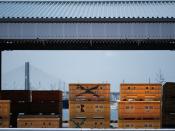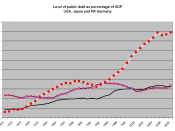1.0 IntroductionClose government-industry cooperation, a strong work ethic, mastery of high technology, and a comparatively small defense allocation have helped Japan become the second largest economy in the world after the United States.
Japan is home to the world's largest bank the Mitsubishi UFJ Financial Group, which has roughly US$1.7 trillion in assets; the world's largest postal savings system; and the largest holder of personal savings, Japan Post, holding personal savings valued at around US$3.3 trillion. It is home to the world's second largest stock exchange, the Tokyo Stock Exchange, with a market capitalization of over US$4 trillion as of December 2006.
This paper analyses the Japanese economy in the 1990s, reviews recent policy changes which were implemented up to the end of 2006, and makes some recommendations for the future.
1.1 BackgroundDuring the 1960s to the late 1980s, Japan experienced unparalleled economic growth that made it the world's second-largest economy.
This was attributed to the following economic factors:â¢Leadership by Japanese manufacturing and service firms , developing efficient production methods, widespread automation and a focus on electronics, automobiles and consumer goodsâ¢High domestic savings rate, increasing the money supply, allowing for easy capital access. This led to high levels of borrowing and investment.
â¢Numerous government-led strategies encouraging overseas export, establishing domestic market demand and a business culture of productivity and R&Dâ¢A labour force with a strong work ethic (productivity) and protected by guaranteed lifetime employmentâ¢The keiretsu system of closely-knit manufacturers, suppliers, distributors and banks to facilitate international tradeWith Japan's economy driven by its high rates of reinvestment, from 1986 to 1990 Japan experienced its asset price bubble. The burst hit particularly hard with the majority of investments made out of the country, and Japanese manufacturing firms losing much of their technological edge . As Japanese products became less competitive overseas,


